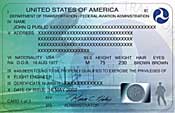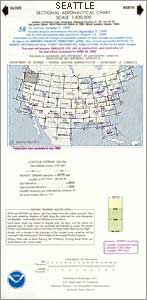






 Once you're in the air, things can happen fast, especially if you're flying to a distant airport. And as experienced pilots know, occasionally the best-laid plans have to be set aside for some quick improvisation. Do you have all of the relevant radio frequencies you will need on your kneeboard? Do you have an accurate assessment of your fuel on board and predicted fuel-burn? Do you know what time you're expected on the ground, and how to contact Flight Service if you're delayed? When flying under Visual Fight Rules (VFR), do you know how to reach Seattle Center for traffic advisories? And perhaps most important of all, are you fit to fly — legally, physically, and mentally?
Once you're in the air, things can happen fast, especially if you're flying to a distant airport. And as experienced pilots know, occasionally the best-laid plans have to be set aside for some quick improvisation. Do you have all of the relevant radio frequencies you will need on your kneeboard? Do you have an accurate assessment of your fuel on board and predicted fuel-burn? Do you know what time you're expected on the ground, and how to contact Flight Service if you're delayed? When flying under Visual Fight Rules (VFR), do you know how to reach Seattle Center for traffic advisories? And perhaps most important of all, are you fit to fly — legally, physically, and mentally?
The time you spend in the air will be more profitable, less stressful, and more enjoyable if you plan for it with some time on the ground — put simply, there is no better preparation for flight than the preflight. Thus, before you yell "Clear!" and fire the ignition, it's a good idea to review the following steps. Whether you're logging your tenth hour or your 1,000th, being fit for flight means a better day for you — and for those who might be flying with you.
Aircraft Preflight
Before you get out your startup checklist, you need to conduct a thorough preflight examination of the airplane you will fly. This means following the steps set out the appropriate Pilot's Operating Handbook or an approved checklist. Be sure you've made a visual examination of fuel and oil levels, and add oil when necessary. Check all moving parts and control surfaces, and inspect the airplane's cowling, wings, fuselage, empennage, and tires for any suspicious wear or damage. Confirm the electrical system is functional, and that the stall horn and landing light are operational. And be sure that the required operating handbook, Airworthiness Certificate, registration papers, and weight & balance data are on board, with the Airworthiness Certificate foremost in the transparent documents envelope.
A good checkout doesn't have to take longer than the flight itself, but it's still required, and normally a patient 15 to 20 minutes spent with your plane on the ground will assure you that you're ready to take it into the sky.
Legal Requirements
 All pilots carrying a valid FAA Pilot Certificate must comply with the following before flying as Pilot in Command:
All pilots carrying a valid FAA Pilot Certificate must comply with the following before flying as Pilot in Command:
- You must possess a current FAA Medical Certificate. If you're under 40, a Third Class Medical is valid for 60 calendar months (five years); after you turn 40, subsequent medicals must be renewed every 24 calendar months (two years).
- You must have completed a Biennial Flight Review within the past two years, with your logbook endorsed by a Certified Flight Instructor.
- If taking passengers, you must have logged three takeoffs and landings within the previous 90 days as Pilot in Command. If taking passengers at night, these conditions also must have been met at night within the previous 90 days.
- You cannot fly if you have consumed any alcohol in the past eight hours, or if your blood alcohol level is 0.04% or higher.
Personal Preparedness
The FAA says that pilots must "self-certify" that they are safe for flight. The "IM SAFE" checklist is always good to review early in the day:
- Illness: Do you have an illness or any symptoms of an illness?
- Medication: Have you been taking prescription or over-the-counter drugs?
- Stress: Are you under psychological pressure from the job? Worried about financial matters, health problems, or family discord?
- Alcohol: Have you been drinking within eight hours? Within 24 hours?
- Fatigue: Are you tired and not adequately rested?
- Eating: Are you adequately nourished?
On Board
 Be sure the following items are in your possession or on board your airplane before departing (a * denotes items you are legally required to carry).
Be sure the following items are in your possession or on board your airplane before departing (a * denotes items you are legally required to carry).
- FAA Pilot Certificate *
- FAA Medical Certificate *
- Photo identification *
- Current sectional *
- Pilot's Operating Handbook * (confirm one is on board the plane if you don't carry a personal copy)
- Any approved checklists
- Airport/Facility Directory or Flight Guide
- Flight plan
When flying cross-country, a few other items in your flight bag could make your day a lot better in the case of any equipment malfunctions or unexpected delays:
- Cellular telephone (not to be turned on or used during flight)
- Handheld aviation radio (fully charged, with backup battery if available)
- Handheld GPS (with fresh backup batteries)
- Flashlight (with backup batteries)
- A high-energy snack, such as a protein bar, and a full bottle of water
Check Out
When renting an airplane from Willamette Aviation, you will have to do the following before heading out to the ramp to preflight:
- Confirm that you are scheduled to check out the plane, and also check to see if anyone has scheduled the plane immediately after you.
- Confirm that the tach time in the aircraft logbook is within 100 hours of last maintenance.
- Fill out and sign the renter's agreement.
- Get the key and fuel card from the aircraft logbook.
Don't forget to check the oil level and fuel the plane after your preflight. If the tanks are mostly full and your flight will be less than two hours, please fuel the plane before tie-down. But also remember — there is rarely a reason to leave the ground with anything less than full tanks, especially when flying cross-country.
Before you go…
More preflight resources can be found here on the WillametteAir.com Flight Deck. Don't forget — it's your responsibility to obtain all available information regarding the route and destination of your flight, so take a few moments to examine the latest METARs and TAFs, see if there are any NOTAMs or TFRs applicable to your flight, and be sure you've jotted down all of the relevant radio frequencies on your kneeboard before you get airborne. Talk to a Flight Service Specialist to get a comprehensive review of the information you've obtained.
And then … have fun!
